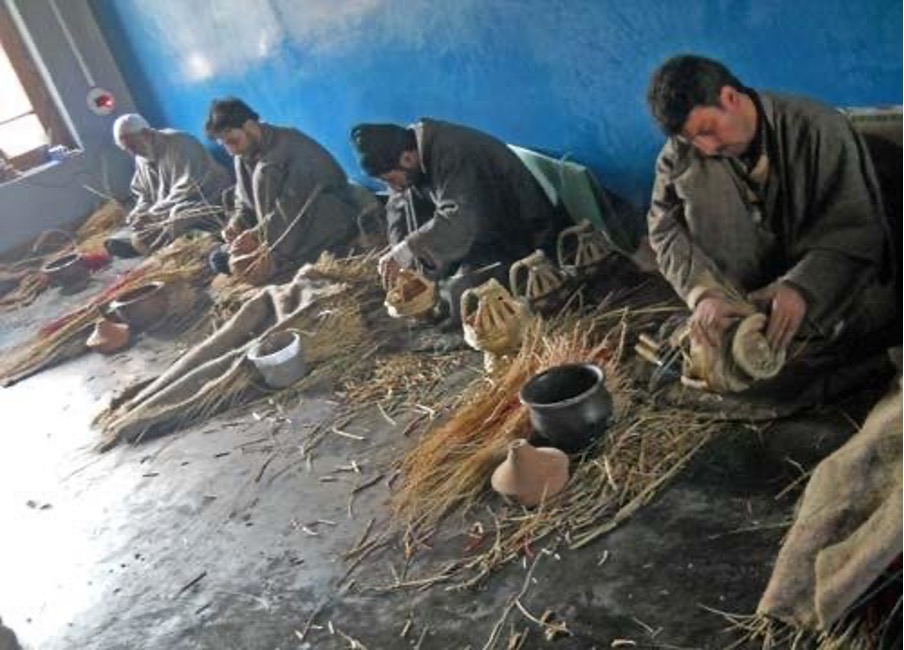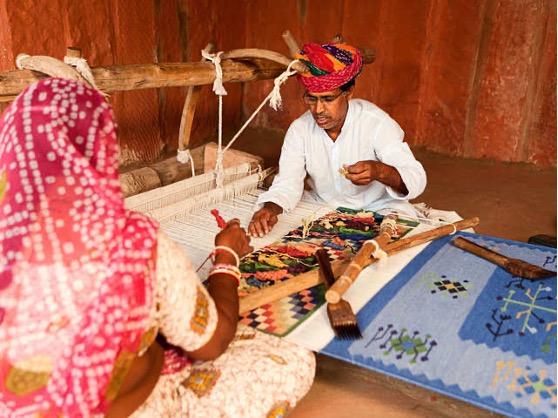The role of cottage industries in economic development and welfare economics is not a new arena. After the second world war, when the global economy faced material deprivation, it would have been absurd to neglect the pivotal role of home industries in the Finnish economic system. Cottage Industries are not a new economic engagement, they were prevalent in the Mississippian economic system, the Ethiopian economic system, as well as other ancient economic systems.
While taking the account of timeline of cottage industries in the Indian, scenario it is varying in nature. Until the British invasion, India was flourishing in the field of rural craftworks. But the exploitative nature of East India Company and Britain led to the shutdown of rural cottage industries.
Later, with the advent of the swadeshi movement, the concept of cottage industries again rolled into the economic mainstream, and during post-independence, the government took various initiatives to foster the economic growth and development through cottage industries. The fate of cottage industry was not consistent; in the early 21st century, the prominence of cottage industry got sidelined with the advent of industrialisation.
At this point it becomes important to analyse the importance of cottage industries in India and address the causes for decline in cottage industries.

In a developing economy like India, the role of cottage industry is dominant in nature. The striking nature of cottage industry is the low requirement of investment. For a developing country, the propensity to save will be less due to limited income and inequitable distribution of wealth. Thus, the investment acting as a catalyst of economic growth and development would be nominal. This lands the developing country in a vicious circle of stagnant growth leading to economic recession. This proves the significance of cottage industries – since it is inclusive in nature due to its low investment pattern, the households can engage in cottage industries under production for trade. Such economic activities increase their income, leading to increase in savings and investments. The Indian economy, which is developing in nature, requires cottage industries to be a catalyst in its economic development.
In this contemporary time, Indian economy is one of the fastest growing major economies, and is the 5th largest economy globally, although this has not been reflected in the socio-economic strata comprising rural households. It is the processes of industrialisation and globalisation that took Indian economy to the farthest point of growth, and it is the same economic processes which resulted in the deterioration of economic life of rural India (exceptional cases notwithstanding). Industrialisation and globalisation made the cottage industries impotent, resulting in their closure. As a result, rural households relocated to urban centres for employment, where they have to face pure forms of exploitation, resulting in deterioration of their standard of living. Thus, there is a wide discrepancy between economic growth and economic development in India.

In this contemporary time, Indian economy is one of the fastest growing major economies, and is the 5th largest economy globally, although this has not been reflected in the socio-economic strata comprising rural households. It is the processes of industrialisation and globalisation that took Indian economy to the farthest point of growth, and it is the same economic processes which resulted in the deterioration of economic life of rural India (exceptional cases notwithstanding). Industrialisation and globalisation made the cottage industries impotent, resulting in their closure. As a result, rural households relocated to urban centres for employment, where they have to face pure forms of exploitation, resulting in deterioration of their standard of living. Thus, there is a wide discrepancy between economic growth and economic development in India.
For bridging this wide discrepancy between economic growth and economic development, it is important to uplift the rural household by giving them command over the economic process of production. This can only be met through proto-industrialisation, through cottage industries. Proto-industrialisation describes a version of industrialisation concentrating on rural development.
Three main features of the Indian economy are a greater number of people engaged in agriculture, unemployment, and more than half of population living in rural areas. Agriculture provides seasonal employment, which makes people employed in agriculture sector to be idle for nearly half a year, and this makes them unproductive for a long period of time. It is this practice which brings the economic life of rural poor at the verge of deterioration. Moreover, since they are unemployed for more than half a year, they are not saving, a cause for investment, and they are consuming without producing.
This practice can be a threat to economic development since there will be more consumption without enough production to catch up with the growing demands. Revamping of cottage industries is the best measure to mitigate these issues. Cottage industries allow the people to continue production during the gap between sowing and harvest. Presently, the unemployment level has shown a relief, though a large number is still unemployed.
Thus, it becomes important to promote employment by converting unemployed to self-employed. Moreover, about 75% of population is unskilled or semi-skilled. Thus, when they shift to urban sector, either they would be exploited or they would remain unemployed. This makes promotion of proto-industrialisation vital for their growth, leading to economic development.

The above three features of Indian economy points to the significance of cottage industries. Unfortunately, cottage industries are at the verge of destruction due to limited money capital, insufficient raw materials to compete with the economic mainstream, and lack in technological education. These causes for the decline in cottage industries should be met by the governing bodies for promoting economic welfare and economic development.
Recently, Chhattisgarh government has implemented the Rural and Cottage Industries Policy-2022 for uplifting the cottage industries. Under this, approval has been given to establish 300 Rural Industrial Parks at Rs 600 crore, arrangements will be made to impart training in appropriate technology for rural and cottage industries and appropriate technology for the future in ITIs, polytechnics etc and granting of subsidies. This is a bold step to revamp the declining cottage industries. These measures must be adopted across India. Along with these measures, it is important to establish cottage industries under the base of rural industrialisation, with the aim of production for trade.
The revamping of cottage industries from its verge of decline is important since it promotes regional and individual specialization, growth of culture and heritage, balanced flow of capital, integrated and inclusive markets, and self-reliance. Moreover, the products of cottage industries are region-specific and the cost of production is minimal, thus they have a comparative advantage. It depends upon the efficiency of cottage industries on what scale it can reap the benefits of the comparative advantage.
By now it is clear that the cottage industries play significant role in the upliftment of rural households. The declining trend of cottage industries can only hamper the economic development and also neglects the economy of poor. As pointed out earlier, India is land of villages, where most of them rely on agriculture which is seasonal, and thus, with the introduction of cottage industries during the period between sowing and harvest, they can contribute to the production of economy by engaging in cottage industries, thus making them production-oriented throughout.

The contribution from this is not minimal because around 75% belong to rural households. Moreover, according to Indian tradition it is an observed trend of females not being employed in rural areas (though the employed rate is more than urban area), according to present statistics only 30% percent of women from rural areas are employed. Against this trend, with the advent of cottage industries, the entire women community would be engaged in the production process since it is a family unity. Thus, increasing the utilization of human resources more over it is a step to bring women community to economic mainstream.
Welfare economics is another surging field of economics of development. Regional disparities, inequitable distribution of wealth, exploitation of working class and their working conditions are all addressed in this field. Rural industrialisation or proto-industrialisation is the key to address the above-mentioned issues. And inception of cottage industries is the initial step for the same. Just consider the instance, which evidently shows how cottage industries can promote rural industrialisation and which in turn promotes economic development. Presently, Indian economy faces regional disparities, inequitable distribution of wealth, exploitation of working class, and their working conditions along with low propensity to save by rural community, and unemployment. In this detrimental scenario, if the fall in cottage industry is addressed, which results in inception of cottage industries. Cottage industries promotes employment for rural poor by transforming the nature of unemployed to self-employed. This provides the rural households, subsistence level of income. Subsistence level of income promotes propensity to save which in turn increases the investment. With increased investments, there would be balanced flow of capitals. The above economic process slowly promotes rural industrialisation, which uplifts the living standards of rural households without shifting them to urban areas, which provides balanced growth between urban and rural areas.
Conclusion
In conclusion, from the above analysis, it is evident that fall in cottage industries is detrimental to economic development which deteriorates, the economics of poor or rural households. One of the major issues is disguised unemployment in agriculture sector and we have seen how introduction of cottage industries can address the issue of disguised unemployment. Decline of cottage industries is a threat to rural industrialisation, which results in inequitable distribution of resources, exploitation of working class, unbalanced flow of capitals, which results in regional disparity, making the rich richer and poor poorer.
Cottage industries are crucial for a developing country like India because only this grassroot level economic activity can promote the welfare economics or economics of development among the rural community. Unfortunately, with the increasing returns from manufacturing sector and service sector, the cottage industries have lost their prominence. It is important to note that cottage industries while comparing to manufacturing or service sector can only give nominal returns or subsistence level of income, but the former can only promote economic growth and not economic development (though it can promote the same indirectly). Thus, this shows how necessary cottage industries are in economic development and how the present decline in cottage industries is detrimental to economic development.
Written by – Kevin Jacob
Edited by – Lavanya Jain




